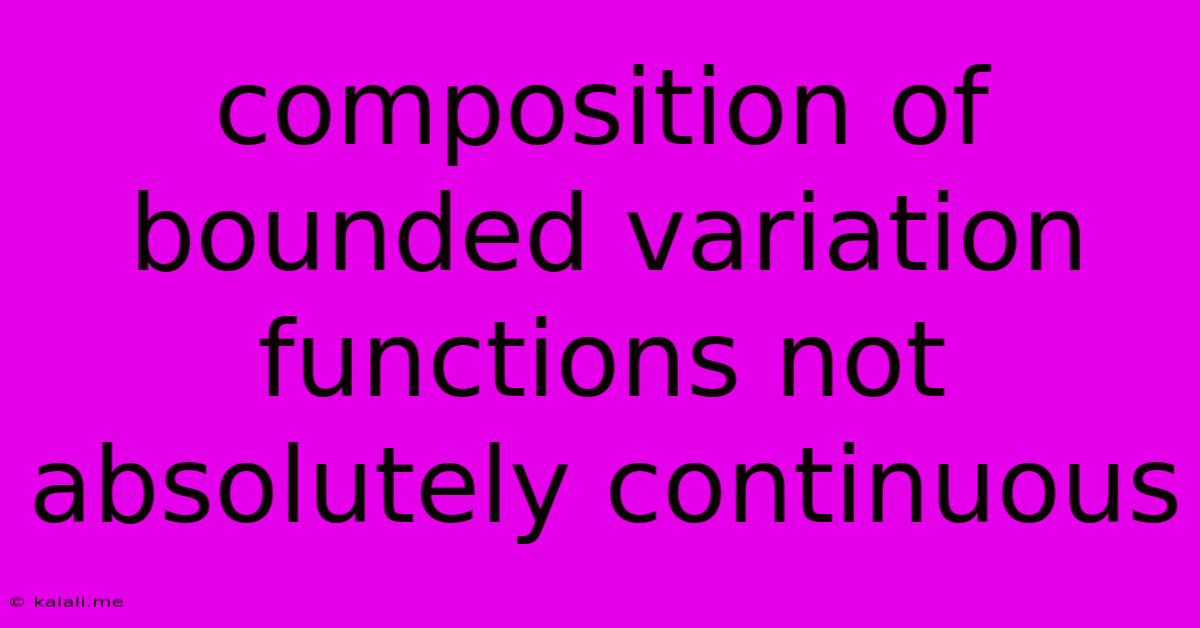Composition Of Bounded Variation Functions Not Absolutely Continuous
Kalali
May 23, 2025 · 4 min read

Table of Contents
The Composition of Bounded Variation Functions: Exploring Non-Absolutely Continuous Cases
This article delves into the fascinating world of functions of bounded variation (BV), specifically focusing on the composition of BV functions that are not absolutely continuous. Understanding this nuanced area is crucial for advanced calculus, analysis, and applications in fields like image processing and geometric measure theory. We will explore the conditions under which the composition of such functions remains BV, and what unique characteristics emerge when absolute continuity is absent.
What are Functions of Bounded Variation?
A function f: [a, b] → ℝ is said to be of bounded variation if the total variation of f over [a, b], denoted by V<sub>a</sub><sup>b</sup>(f), is finite. This total variation essentially measures the total accumulated change of the function over the interval. Intuitively, a function of bounded variation has limited "oscillation" – it doesn't wildly fluctuate. This property is stronger than mere boundedness; a bounded function need not be of bounded variation. Examples include monotone functions and functions with finitely many discontinuities.
Absolutely Continuous Functions: A Subset of BV
Absolutely continuous functions (AC) form a crucial subset within the broader class of BV functions. A function f is absolutely continuous if for every ε > 0, there exists a δ > 0 such that for any finite collection of disjoint intervals [(x<sub>i</sub>, y<sub>i</sub>)] in [a, b], the condition ∑<sub>i</sub>|y<sub>i</sub> - x<sub>i</sub>| < δ implies ∑<sub>i</sub>|f(y<sub>i</sub>) - f(x<sub>i</sub>)| < ε. This is a much stronger condition than continuity; it essentially states that small changes in the input lead to small changes in the output, uniformly across the entire domain. All absolutely continuous functions are of bounded variation, but the converse is not true. The Cantor function provides a classic counterexample.
Composition of BV Functions: When Things Get Interesting
Let's consider the composition of two functions, g ◦ f, where f and g are functions of bounded variation. If both f and g are absolutely continuous, then their composition g ◦ f is also absolutely continuous, and hence of bounded variation. However, the situation becomes more complex when we relax the absolute continuity condition.
The Non-Absolutely Continuous Case: Exploring the Boundaries
The composition of two BV functions, where at least one is not absolutely continuous, does not automatically guarantee that the resulting function is also BV. The behavior of the composition hinges significantly on the interplay between the variations of f and g. While a general, easily stated condition for the composition to remain BV is elusive, specific scenarios can be analyzed:
-
Piecewise Monotone Functions: If both f and g are piecewise monotone and of bounded variation, then their composition g ◦ f will also be of bounded variation. This is because the total variation can be assessed piecewise, and the monotonicity aids in bounding the variation on each piece.
-
Singular Functions: The composition of two singular functions (functions with zero derivative almost everywhere but not constant), like the Cantor function, can lead to surprising results. Analyzing these requires more sophisticated tools from measure theory.
-
Role of the Derivative: While the derivative of a BV function might not exist everywhere, it exists almost everywhere. The behavior of the derivatives of f and g near points where they are not absolutely continuous is vital in determining the bounded variation of the composite function.
Advanced Techniques and Further Study
Further investigation into the composition of non-absolutely continuous BV functions often involves:
- Measure Theory: Utilizing concepts like the Radon-Nikodym derivative and Lebesgue-Stieltjes measures is often essential to quantify the variation.
- Geometric Measure Theory: This field provides powerful tools for analyzing functions with fractal-like properties, which often arise in the context of non-absolutely continuous BV functions.
Conclusion:
The composition of bounded variation functions presents a rich landscape of mathematical challenges. While the case where both functions are absolutely continuous is straightforward, the non-absolutely continuous scenario requires careful analysis and frequently demands advanced mathematical machinery. Understanding the intricacies of these compositions is crucial for a deeper grasp of function spaces and their applications in various fields. Further exploration of specific examples and rigorous theoretical investigations will continue to expand our knowledge in this fascinating area.
Latest Posts
Latest Posts
-
Another Word For A Man Who Sleeps Around
May 23, 2025
-
Abide In Me And I In You
May 23, 2025
-
Latex How To Do Bullet Points
May 23, 2025
-
Rock Paper Scissors But You Can Use Anything
May 23, 2025
-
How To Remove A Broken Screw In Metal
May 23, 2025
Related Post
Thank you for visiting our website which covers about Composition Of Bounded Variation Functions Not Absolutely Continuous . We hope the information provided has been useful to you. Feel free to contact us if you have any questions or need further assistance. See you next time and don't miss to bookmark.